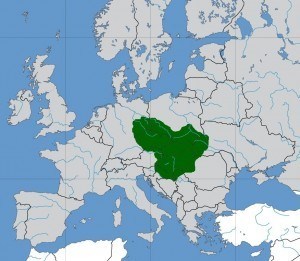United we stand, divided we falter. This classic maxim has been a lesson taught since ancient times. It pertains to the fact that when a people stand united in the face of their enemies, they are stronger and no one can defeat them. However, when instead they are divided and squabble between themselves over petty issues, the enemy can easily pick them off one by one and conquer them.
This lesson gets repeated over and over, yet history is full of stories when it was not listened to. One of these times is recounted in the Parable of the Three Twigs of King Svatopluk.
Svatopluk (sometimes referred to as a king, sometimes as a duke) was the ruler of the Great Moravian Empire, situated in central Europe. He was arguably one of the empire’s greatest rulers, having expanded its border into far-away lands.
He was a wise, but also cunning ruler, who had a knack for always coming up with the right solution to a problem. However, no one is eternal and his rule too had to come to an end. He had grown old and it was time to pass the empire he built to his sons.
The Lesson Of King Svatopluk
The story of the three twigs of King Svatopluk is a parable that tries to teach people the benefits of remaining united and not absorbed in petty squabbles.
It starts with him being on his deathbed. He summons his three sons and tells them his will. Previously, he had divided the country into three parts, each to be ruled by one of his sons, with the eldest son to become the overall ruler of the entire empire, and the two other sons being his subordinates.
Being the wise ruler that he was, he goes on to give a warning, telling them to remain united and not to go one against another. Knowing that demonstrations are often stronger than words, the dying king proceeds to try to teach them this lesson through the use of an analogy.
Svatopluk takes three twigs, binds them together and gives them to his eldest son asking him to break them. The eldest son tries his hardest, but does not succeed in breaking the three twigs. Svatopluk then gives the same three twigs to his second eldest son and then also the third. None of them succeed in breaking them.
After that, Svatopluk takes the three twigs, unbinds them and gives each of the twigs to the individual sons. He then tells the sons to try to break the individual twigs that they are holding in their hands. They succeed in doing this without much effort.
This was the lesson that he wanted to impart to them. Bound together, the three twigs are unbreakable, however when unbound and separate, each of the twigs can be broken quite easily.
The three twigs together were meant to represent the three sons united together, while the individual twigs were meant to represent what would happen to each of the sons, if they stood alone.
If they remain united, then no enemy will be able to touch them and they will live long and prosperous lives. However if they start fighting among each other, the enemy will be able to pick them off one by one and they will be destroyed.
The End Of An Empire
History has proven Svatopluk to be right. When he was dying, the Great Moravian Empire was at its largest extent, controlling territory extending from parts of Germany and southern Poland, all the way to eastern Austria, all of Hungary and into Slovenia, Serbia and western Romania. The heartland of the empire were the lands that now form the Czech Republic and Slovakia. It was the most predominant power in the region, renowned for its fierce warriors and a center of culture.
The sons unfortunately did not listen to their father. Shortly after Svatopluk died, the three sons started internal infighting, each of them trying to gain the throne for themselves.
Mojmir II was the heir and successor of Svatopluk. However his brother Svatopluk II, who ruled the Principality of Nitra, a territory within the Great Moravian Empire, rebelled against him. He was supported in this by Arnulf of Carinthia, who was the ruler of neighboring East Francia.
During the internal fighting between the brothers, large territories of the Great Moravian were either conquered by others or broke away. Pannonia was conquered by the Eastern Franks, and territories like Lusatia also ended up being conquered by Arnulf. Bohemia broke away to become an independent state.
Then in 900, the final death knell came. The much weakened, bickering and divided empire was invaded by the Hungarians, nomads originally from the steppes of Central Asia. The Hungarians wreaked havoc on the country and both brothers probably died in 906, a year of intense fighting and many battles.
After that date, the Great Moravian Empire was no more. Some of the territory lingered on as independent principalities for a few more decades, but the largest bulk of the country was conquered by the Hungarians, who ended up settling on parts of the territory and ruling the surrounding lands for almost a millennium.
The Lesson For Your Personal Life
What are the lessons be learned here? Oftentimes people don’t see the forest for the tip of their nose. They engage in petty squabbles with their brothers, men who should be their natural allies, while the real enemy lurks and waits for an opportune moment to strike.
It is then very easy to pick them off one by one, since divided they fall. History has taught this lesson over and over again, yet it seems like many men of all eras don’t take heed of it and don’t remember this lesson.
Pride goes before the fall. Many a great man would have survived and gone on to prosper if they had heeded this maxim. Instead, hubris took over their minds and souls, they grew too ambitious and turned on their brothers and friends.
Then the real enemy hordes came, and instead of facing a united front, they faced a divided nation. This state of affairs handed the enemy the victory on a silver platter.
This is an important lesson for your personal life. Remember who your real friends and brothers are and remain united with them. Together you are stronger and can fight off any enemy. Divided, you will be easy pickings for anyone who comes along.
Read More: The Curse Of Hubris: The Rise And Fall Of The Marquis De Pombal



The Bulgarians have exactly the same story with their king Kubrat and his five sons (VIII century). And so did the Scythian king Skilurus with his sons (2nd century BC).
But the oldest original is perhaps the Aesop’s fable “The Bundle of Sticks”.
http://www.umass.edu/aesop/content.php?n=4&i=1
Nevertheless, the moral of the story is eternal.
Bundle of sticks is a “faggot”.
Perhaps this is the connection with the notion that people who are all full up on drama, intrigue, and backstabbing are “being a faggot”.
I wonder how it came to be slang for “butt pirate.”
And on the reverse side, isolate our enemies from social support.
Trust me, people will egalitarian personalities have VERY fearful responses to being cut off from social circles, far more so than we do. It’s a potent weapon against them.
Very true. I’m surprised the left hasn’t torn itself to pieces yet. They have so many factions that normally despise each other. It wouldn’t take much to set them loose on each other.
“It wouldn’t take much to set them loose on each other.”
Ding ding ding! Correct answer!
The only thing that holds them together is their fear of reality.
If you look through history, whenever a leftist revolution gains power, the first thing they do is engage in ideological purges against more moderate leftists.
It’s informational.
For example, every time there’s some report about proof of a “gay gene”, it gets little press because the pro-abortion crowd and the gay crowd have an alliance. If parents are told that little Timmy is going to grace their household someday by bringing home his big black boyfriend from college, off to the abortion clinic they go.
The “abortion anytime anywhere no reason needed” crowd and the gays won’t be friends if that happens.
TERFs versus trannies is another one. Women who want to eradicate sexual differences don’t get along well with people “transitioning” meaning that “sexual traits” are in fact something they are all about. Trouble ensues. But these tend to be very small minorities on both sides and most of them are mentally ill so it does not get a lot of coverage.
Setting them against each other is possible, but while our enemies have think tanks that devise ways to fuck with the people, we have yet to come up with our own to see to the same ends.
(though a good think tank is a secret one so who knows)
turn this story around and you will see the key to defeating your enemies is to divide them and turn them one against the other….
Yeah, I think it’s called the “third wave” or something like that. Insert dissension in their group and they split apart. Then you take over.
Good column.
This echoes deep. Can man take his eyes off of his ambition for the sake of keeping his world together, or will the burning desire in his heart consume everything he knows so that his desires come to fruition? Only the strong, the truly strong, can overcome this.
You can’t put a wise head on young shoulders. Unfortunately, it takes a long time for most men to mature, that’s why Plato for example stipulated that men shouldn’t become leaders until at least 35 (the Republic). It’s really difficult to know if women have that capacity to mature- I feel women develop more quickly, but, stay at the same level in their public roles for their whole careers.
Svyatopolk (“Saint army” in old /slavonic) is the right spelling.
Ah yes, the fable of the faggot. A stick is weak, but a faggot is strong! Let all us men band together to form a mighty faggot! If we did this in cities across the country and world, we could be many faggots! FAGGOTS UNITE!
haha
Well, this hit a little close to home, me being the youngest of three brothers. The eldest of which has resigned himself to be a Beta Provider. Poor guy.
I have found that those who rant the hardest about disunity are the very people who cause it by refusing to accept internal differences within the group that supposedly should remain united. If your basis for unity is “everyone should do/be as I say”, you aren’t helping. Everyone can agree to unity (or coexistence, for that matter), as long as he gets to dictate on what terms it happens.
The same thing appears in Kurosawa’s film, Ran – the king puts his sons to break a bundle of arrows to teach them a lesson about sticking together. Two of them can’t, put the third uses his leg to put much more pressure on the arrows and finally breaks them. The sons laugh at their father’s silly parable and in the end they turn against each other and against their father.
Rep for mentioning that masterpiece. The fallen daymio’s subsequent descent into madness was oscar worthy.
brilliant film
Brilliant film. Based on King Lear.